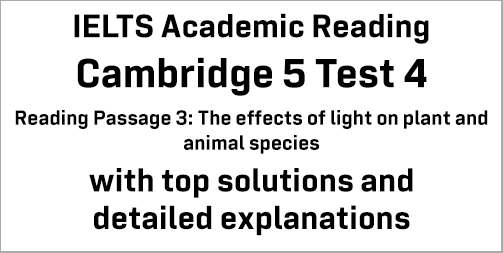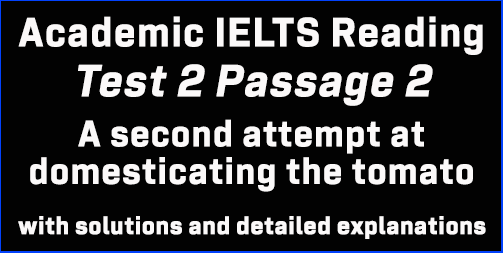IELTS Academic Reading: Cambridge 5 Test 4 Reading passage 3; The effects of light on plant and animal species; with best solutions and best explanations
This Academic IELTS Reading post focuses on solutions to IELTS Cambridge 5 Reading Test 4 Reading Passage 3 which is titled ‘The effects of light on plant and animal species’. This is a targeted post for IELTS candidates who have big problems finding out and understanding Reading Answers in the AC module. This post can guide you the best to understand every Reading answer without much trouble. Finding out IELTS Reading answers is a steady process, and this post will assist you in this respect.
IELTS Cambridge 5 Test 4: AC Reading Module
Reading Passage 3: Questions 27-40
The title of the passage: The effects of light on plant and animal species
Questions 27-33: TRUE, FALSE, NOT GIVEN
[In this type of question, candidates are asked to find out whether:
The statement in the question agrees with the information in the passage – TRUE
The statement in the question contradicts with the information in the passage – FALSE
If there is no information on this – NOT GIVEN
For this type of question, you can divide each statement into three independent pieces and make your way through with the answer.]
Question no. 27: There is plenty of scientific evidence to support photoperiodism.
Keywords for the question: plenty of, scientific evidence, support, photoperiodism,
Take a look at lines 5-6 in paragraph no. 2, “ . .. . The seasonal impact of day length on physiological responses is called photoperiodism, and the amount of experimental evidence for this phenomenon is considerable. .. .. .”
Here, experimental evidence = scientific evidence, considerable = plenty of,
So, the answer is: TRUE
Question no. 28: Some types of bird can be encouraged to breed out of season.
Keywords for the question: some types, bird, can be encouraged, breed, out of season,
In paragraph no. 2, lines 7-8 say, “ . .. For example, some species of birds’ breeding can be induced even in midwinter simply by increasing day length artificially (Wolfson 1964). .. .”
Here, some species of birds = some types of bird, induced = encouraged, even in midwinter = out of season,
So, the answer is: TRUE
Question no. 29: Photoperiodism is restricted to certain geographic areas.
Keywords for the question: Photoperiodism, restricted, certain geographic areas,
In paragraphs no. 2, 3 and 4 the writer mentions ‘temperate zones’ – areas of the world that have a temperate climate. However, no mention of any geographical restriction of photoperiodism can be found in this passage.
So, the answer is: NOT GIVEN
Question no. 30: Desert annuals are examples of 1ong-day plants.
Keywords for the question: desert annuals, examples, long-day plants,
In paragraph no. 4 the writer says at the end, “. .. . . For example, desert annuals germinate, flower and seed whenever suitable rainfall occurs, regardless of the day length.”
Here, regardless of the day length = day-neutral,
This means desert annuals are examples of day-neutral plants, NOT long-day plants.
So, the answer is: FALSE
Question no. 31: Bamboos flower several times during their life cycle.
Keywords for the question: bamboos, flower, several times, during, life cycle,
At the beginning of paragraph no. 5, the author writes, “Bamboos are perennial grasses that remain in a vegetative state for many years and then suddenly flower, fruit and die (Evans 1976). … ..”
Here, suddenly flower, fruit and die = flower one time during life cycle,
Then, the writer provides some statistics to support the sentence.
So, the answer is: FALSE
Question no. 32: Scientists have yet to determine the cue of Chusquea abietifolia’s seasonal rhythm.
Keywords for the question: scientists, yet to determine, cue, Chusquea abietifolia’s seasonal rhythm
Again, in paragraph no. 5, the writer says in lines 3-6, “. .. Every bamboo of the species Chusquea abietifolia on the island of Jamaica flowered, set seed and died during 1884. The next generation of bamboo flowered and died between 1916 and 1918, which suggests a vegetative cycle of about 31 years. The climatic trigger for this flowering cycle is not yet known, but the adaptive significance is clear.”
Here, The climatic trigger for this flowering cycle = Chusquea abietifolia’s seasonal rhythm, not known yet = Scientists have yet to determine,
So, the answer is: TRUE
Question no. 33: Eastern hemlock is a fast-growing plant.
Keywords for the question: Eastern hemlock, fast-growing plant,
For this question, we need to go to the final paragraph. In the beginning of the paragraph, the writer says in lines 2-3, “ .. . .. Shade-tolerant plants have lower photosynthetic rates and hence have lower growth rates than those of shade-intolerant species. .. .”
Then, in line no. 7, the writer says, “ . .. . For example, eastern hemlock seedlings are shade-tolerant.”
As eastern hemlock is shade-tolerant plant, it has lower growth rate (slow-growing plant).
So, the answer is: FALSE
Questions 34-40: Completing sentences with NO MORE THAN THREE WORDS
In this type of question, candidates are asked to write a maximum of three words to complete sentences on the given topic. For this type of question, first, skim the passage to find the keywords in the paragraph concerned with the answer, and then scan to find the exact word.
[TIPS: Here scanning technique will come in handy. Target the keywords of the questions to find the answers. Remember to focus on Proper nouns, random Capital letters, numbers, special characters of text etc.]
Question no. 34: Day length is a useful cue for breeding in areas where ________ are unpredictable.
Keywords for the question: day length, useful cue, breeding, areas, unpredictable,
The writer says in paragraph no. 2 in lines 2-5, “ .. . .. Day length is an excellent cue, because it provides a perfectly predictable pattern of change within the year. In the temperate zone in spring, temperatures fluctuate greatly from day to day, but day length increases steadily by a predictable amount. . .. ”
Here, excellent cue = useful cue, fluctuate greatly from day to day = unpredictable,
So, the answer is: temperatures
Question no. 35: Plants which do not respond to light levels are referred to as _________.
Keywords for the question: plants, do not respond, light levels, referred to, as,
First, in lines 5-7, the writer explains the term that deals with response to light levels, “ .. . The seasonal impact of day length on physiological responses is called photoperiodism, and the amount or experimental evidence for this phenomenon is considerable. .. . ”
Then, in lines 11-12 of the same paragraph, the writer says, “ . .. . Plants which flower after a period of vegetative growth, regardless of photoperiod, are known as day-neutral plants.”
Here, regardless of photoperiod = do not respond to light levels, known as = referred to as,
So, the answer is: day-neutral (plants)
Question no. 36: Birds in temperate climates associate longer days with nesting and the availability of __________.
Keywords for the question: birds, temperature climates, associate, longer days, nesting, availability of,
Let’s have a close look at paragraph no. 3. Here, the author of the passage says in lines 4-6, “ . .. . Thus many temperate-zone birds use the increasing day lengths in spring as a cue to begin the nesting cycle, because this is a point when adequate food resources will be assured.”
Here, temperate-zone birds = Birds in temperate climates, increasing day lengths = longer days, will be assured = availability,
So, the answer is: (adequate) food (resources)
Question no. 37: Plants that flower when days are long often depend on _________ to help them reproduce.
Keywords for the question: plants, flower, days are long, often, depend on, help them reproduce,
The answer to this question can be traced in paragraph no. 4, in lines 3-4, “ . .. Long-day plants are adapted for situations that require fertilization by insects, or a long period of seed ripening. .. .”
Here, Long-day plants = Plants that flower when days are long, require = depend on,
So, the answer is: (fertilization/fertilisation by) insects
Question no. 38: Desert annuals respond to ________ as a signal for reproduction.
Keywords for the question: desert annuals, respond, as a signal, reproduction,
The answer can be found in the last lines paragraph no. 4, “ .. . Day-neutral plants have an evolutionary advantage when the connection between the favourable period for reproduction and day length is much less certain. For example, desert annuals germinate, flower and seed whenever suitable rainfall occurs, regardless of the day length.”
Here, germinate, flower and seed = respond,
So, the answer is: (suitable) rainfall
Question no. 39: There is no limit to the photosynthetic rate in plants such as___________.
Keywords for the question: no limit, photosynthetic rate, plants, such as,
In paragraph no. 6, the last few lines say, “ . .. Some plants reach maximal photosynthesis at one-quarter full sunlight, and others, like sugarcane, never reach a maximum, but continue to increase photosynthesis rate as light intensity rises.”
Here, never reach a maximum = no limit to the photosynthetic rate,
So, the answer is: sugarcane
Question no. 40: Tolerance to shade is one criterion for the ________ of plants in forestry and horticulture.
Keywords for the question: tolerance to shade, one criterion, plants in forestry and horticulture,
The first two lines of the final paragraph give us the answer to this question. The author says here, “ . .. . Plants in general can be divided into two groups: shade-tolerant species and shade-intolerant species. This classification is commonly used in forestry and horticulture.
Here, shade-tolerant species and shade-intolerant species = tolerance to shade,
So, the answer is: classification
Click here for solutions to Cambridge 5 AC Test 4 Reading Passage 1
Click here for solutions to Cambridge 5 AC Test 4 Reading Passage 2




You really being helpful
You really being helpful, thanks????